The B2M Analog
The Analog will be B2M's full-scale testing and training module.
|
| There's nothing more radical than a working model of a better way. |
| ‒ Walt Patrick
|
Designing for the Initial Application
Proof of Concept
Modules Built from Shipping Containers
On-site Staff Housing
B2M for Dummies
chipped forest thinnings
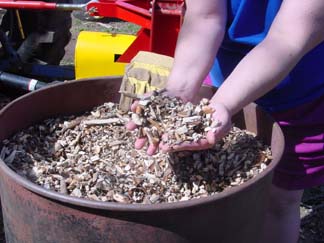 | | |
Designing for the Initial Application
The B2M concept can be configured to utilize a wide variety of inputs and to produce an equally wide variety of products, but one has to start by focusing on the resources and needs of a specific location.
While the ultimate vision involves a B2M system embedded at the heart of a resilient rural village, the more immediately relevant configuration involves creating a portable B2M plant that can be brought to a locale with a large surplus of waste biomass to process. An example would be the site of a large logging operation or a forest that needed thinning and fuel removal to ensure its future good health.
Loading woody biomass in the field and then transporting it to a central processing location is a significant logistical challenge. Either specially constructed vehicles are needed to haul and unload chipped wood, or special unloading equipement is needed similar to what our local landfill uses to unload shipping containers crammed full of Muniscipal Solid Waste (MSW).
emptying out a shipping container
filled with MSW
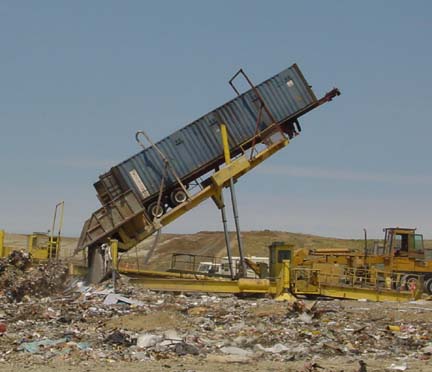 | | |
One of the guiding visions of the B2M project is that forest health is better served by bringing the plant to the forest instead of trucking the forest to the plant. By using a small facility to process waste at point of generation, smaller equipment can be used to accomplish the work, thereby lessening the disruption of forest ecosystems.
| | a slash pile at a nearby logging site
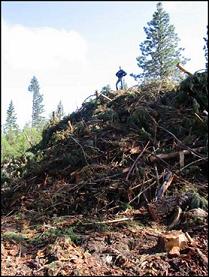 | | |
Perhaps most important is the ability of a B2M facility to protect future forest health by returning the ash left over to the forest. Current commercial practice involves stacking up logging waste in a huge pile, and then returning to burn it the next winter.
Not only is this practice very detrimental to local air quality, it leaves the nutrients contained in the ash concentrated in one place rather than returning them to the forest where they can be incorporated into the next generation of trees.
For every hundred pounds of woody biomass processed, a gasification facility will have to dispose of an average of three pounds of ash. A large, stationary gasification plant would need special-built trucks to haul this waste to a landfill. A small, portable plant can just load the ash into the hopper of a standard fertilizer spreader mounted on the back of a standard tractor, and return it to the forest that produced it.
a 3-point hitch mounted fertilizer spreader
 | | |
Ash that would constitute a waste management problem for a stationary facility would be returned to the forest by a portable facility where it would ensure the future productivity of the forest.
Resource extraction industries consume large quantities of liquid fuels which have to be transported from the refinery to the job site. For example, the mining of coal consumes large quantities of diesel fuel‒if diesel is unavailable, coal mining shuts down. Without diesel to fuel the trains that bring coal to the electrical generating plants, the grid shuts down.
Fuel produced by an onsite B2M plant could be used onsite to the economic benefit of both the B2M plant and the loggers, and the environmental benefit of everyone since every gallon of fuel not burned in transporting fuel means 19 pounds less carbon dioxide added to the atmosphere.
To recap, B2M's initial model is being designed to take a locally generated input (logging waste) and convert it to locally consumed fuels (methanol).
Proof of Concept
For years, the Windward crew has been gathering components for the various subsystems that have to function successfully in order to accomplish the small-scale transformation of woody biomass into liquid fuel. Now it's time to start connecting those components into a system, but to do that requires creating a model facility to house the project.
Each aspect of the B2M Project has been well established, in some cases, for decades. What has to be shown is that these components can work in concert at this scale. While we think that this is reasonable, reasonable enough that we have dedicated a considerable amount of our resources to the project, still the track record for new technologies is such that it's prudent to get a working model set up, operational and debugged before urging its widespread adoption.
the Analog's future home
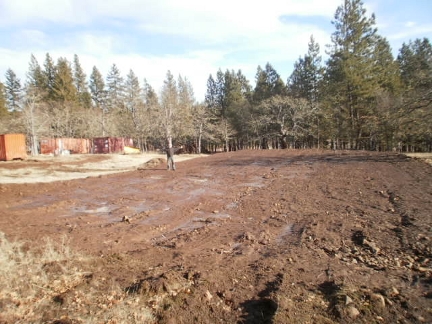 | | |
In projects such as this, long experience suggests that most everything takes longer, costs more and turns out differently than was thought going in. There's little doubt that much will be learned in the process of getting an actual plant converting wood chips into fuel, and that by documenting those lessons‒some of which will not be the nice kind‒this project will enable others to adopt this technology more quickly, effectively, and most importantly, reasonably safely.
The skills needed to handle this technology are often closely held for reasons ranging from trade secrets to an effort to limit liability. It is our hope that by speaking frankly about what we're learning in an open-source context, others will recognize the public service potential of this work and lend their support.
Modules Built from Shipping Containers
Shipping containers are one of today's great creative resources. They're especially ideal for containing a project which deals with high temperatures and various types of fuels. A quick search of the web will show shipping containers that are serving as housing, offices, workshops, emergency shelters, and dozens of other uses.
In addition to the containers themselves, there are a variety of specialty built tools to facilitate moving them from one location to another. A prime example is the special-built, tilt bed trailers that make the loading or unloading of a container into a quick, one-person, fifteen minute job.
a special built
container delivery trailer
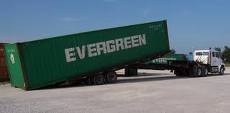 | | |
The use of shipping containers to house a B2M plant will enable the efficient production of custom systems to be produced efficiently in one location, and then delivered by conventional means to where they're needed. This will result in cheaper and faster depolyment, and more reliable initial operation, than would be possible if each unit were to be constructed by a different group at each potential location.
The construction of an Analog will also enable a crew of operators to come to a central location to learn how to operate an existing, debugged unit before returning home to tackle the challenge of integrating a B2M plant into their local circumstances.
On-site Staff Housing
Moving a portable B2M plant to the biomass elimenates the cost of loading, hauling, and unloading an ongoing stream of biomass; the next step would be to ensure the energy saved wasn't consumed by an increase in the amount of time and energy spent by the staff commuting to the plant. A B2M plant would operate continuously, so trained staff would need to be on site around the clock. Instead of having staff commute, a practical solution would seem to be to include appropriate staff housing in the design of the plant.
A B2M plant could be designed to operate in a manner similar to a cargo ship in that people could live and work on-site. Four people could staff a plant in shifts of 4-hours-on and 8-hours-off with one person off each week in a 21-days-on and 7-days-off rotation. The day shift could focus on outdoor tasks such as gathering slash, feeding slash into the chipper, and spreading ash in the forest, with the night shift monitoring and maintaining the gasification/conversion equipment.
Below is one possible configuration using three standard shipping containers to create a 23'x40' lower floor, and an 8'x40' upper floor.
a three shipping container layout
(dimensions are in feet)
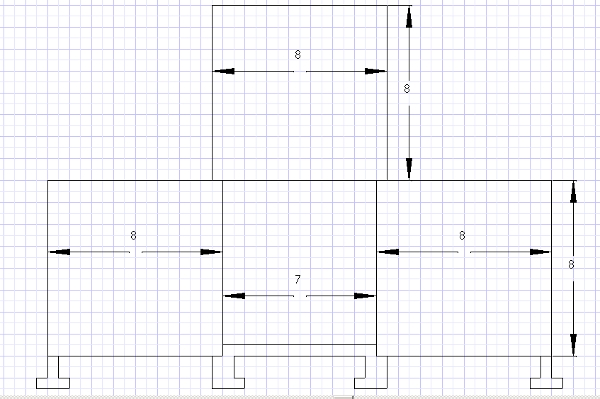 | | |
The Analog will consist of six containers arranged in two sets of three, as shown above. The second set of three containers will be located ten feet behind from the first set, with the upper container shifted forward ten feet to connect with the upper container of the first set.
The first set of containers will provide housing for the staff, while the second set of containers will create a work area which is both well protected from the elements and well ventilated.
B2M for Dummies
Over the past decade, there has been a long string of books offered on the theme of resolving something complicated to the point where even an unprepared person can look to be successful at some complicated undertaking. It is not the goal of this website to simplify the conversion of woody biomass into fuel to the point where an unprepared person can use this technology successfully. If someone is looking for the easy, quick way to energy independence, this is not it.
Instead, this project is intended to create a collaborative platform that can enable those who are willing to learn a variety of technologically challenging disciplines to do something that makes radical change possible. Those who choose to follow this path need to be willing to study the work, and the wreckage, of those who've gone before. They need to be eager to study the chemistry and physics involved, to delve into the fundamental processes that form the basis of an alchemy that is so powerful that it can turn waste into wealth, that it can breath life back into isolated communities that are being strangled by high energy costs.
A key reason for constructing an Analog is to make it possible for students of the process to come and gain hands-on experience, but such work will come only after a person has done their homework. The good news is that the internet has made it possible for individuals to seek out high quality instruction, and many colleges now offer on-line courses to those who are eager learn but lack local options.
It's only after the theory is mastered that one can, with reasonable safety, undertake to gain hands-on experience with potentially lethal technologies and techniques. With theory well in hand, it's time to head to the lab to calibrate one's understanding of the process. A key goal of the Analog is to provide serious students with a working lab in which they can prepare themselves to make biomass-to-fuel conversion work with their resources in a way that meets their community's needs.
the US Merchant Marine Academy's
engineering training facility
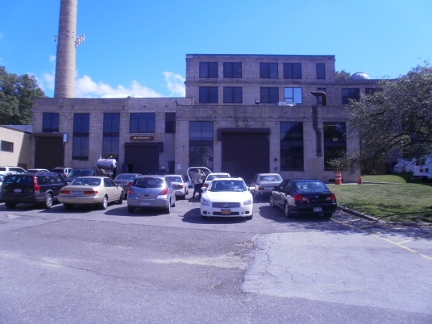 | | |
The idea for the Analog came from the way that the United States Merchant Marine Academy trained its engineering students. The King's Point campus was heated and powered with an on-site power plant that was essentially the same system that powered a cargo ship. The only difference was that a ship-board power plant rocked back and forth with the ocean swells; the Academy's power plant didn't.
The Academy's Analog was the real thing, only it didn't travel from port to port. Instead, it stayed in one location to enable students to stand watch, perform basic maintenance functions, and learn most of what they needed to know in order to operate such a system on the high seas.
|
|